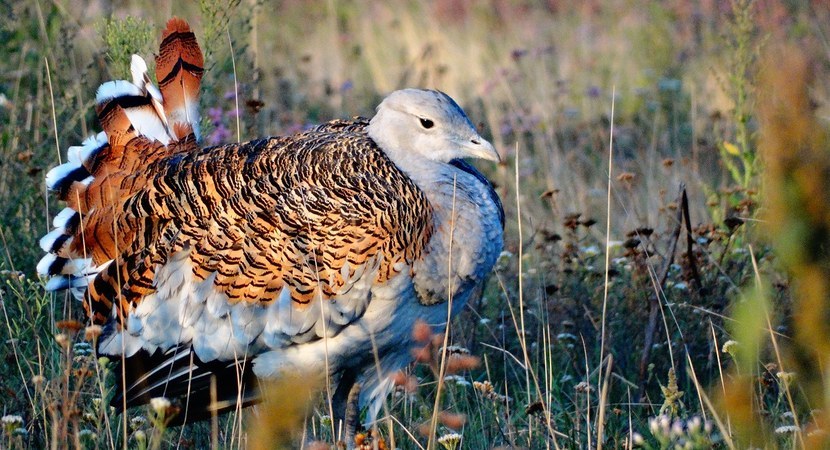The State Forests wants to re-establish the great bustard
This year, the State Forests has begun a reintroduction project of the great bustard. In Poland, the last wild great bustards died off in the late 1980s.
The main objective of the project ‘Reintroduction of the great bustard Otis tarda on the territory of the Republic of Poland’ is to create a free-living population of these birds.
At the beginning, the University of Zielona Góra - one of the partners to the programme, will prepare a Project Feasibility Study, which is a document constituting the substantive basis for the entire project. This will be a compendium of knowledge about how to raise young birds and about the places in agricultural landscape of western Poland (where the last wild great bustards existed) suitable for their resettlement. The document will also indicate the principles of cooperation with farmers and the ways of financing such plantations which are suitable for the bustard.
The Forest Gene Bank ‘Kostrzyca’(FGB) involved in the project, will determine the population that will be genetically appropriate to set up the breeding flock. In the future, FGB will be responsible for keeping records in a flock book and for managing genetic resources.
The project will use experience in the field of breeding and reintroduction of bustards developed by ornithologists from Germany, Hungary and Great Britain. The obtained birds will go to the Great Bustard Breeding Centre in the Świebodzin Forest District, which is being built at the moment, and the show aviary at the Warsaw ZOO.
The main burden of breeding will rest on the Świebodzin Forest District (Regional Directorate of SF in Zielona Góra). This is where the birds, which are going to be freed after a several-stage adaptation process, will come from.
It is worth noting that larger populations of the great bustard in Europe are in Germany (Brandenburg), on the border of Austria, the Czech Republic and Slovakia, in Spain, Hungary and Russia. Attempts to reintroduce bustards are made in Great Britain and Sweden.
The great bustard is one of the heaviest bird species which is capable of active flight. Males can reach a mass of 16-18 kg, and they are even heavier than mute swans. Females are lighter and much smaller, as they weigh only 4-6 kg.
These birds prefer vast open spaces. However, along with the transformation of landscapes and habitats, caused by intensification, mechanisation and chemicalisation of agriculture, as well as emerging monocultures of crops, changing cultivated plant species, densifying power lines, rail transport and agriculture, it was increasingly difficult to find optimal conditions for themselves to live. All the more so because it is a species that is not ecologically flexible and it can hardly adapt to new environmental conditions. This resulted in a drastic decrease in number, and, eventually, caused the complete disappearance of the entire domestic population.
Poaching and increasing population of fox also became a problem.
The European countries that deal with the active protection of the great bustard want Poland to become a signatory to the Memorandum of Understanding on the Conservation and Management of Middle-European Populations of the Great Bustard – a multilateral agreement under the auspices of the Convention on the Conservation of Migratory Species of Wild Animals whose aim is to protect the population of bustard in Central Europe. The document contains guidelines for the protection of this species: including shaping habitats and eliminating threats.
On the other hand, as far as reintroduction is concerned, the recommendations of the International Union for Conservation of Nature (IUCN) indicate that the individuals can be re-established only if the causes of extinction have been eliminated.
Owing to the fact that potential habitats are not under the State Forests administration, close cooperation with landowners, farmers and infrastructure managers will be necessary. To achieve this goal, it will be essential to select an area in which anthropogenic threats will not occur, and the natural ones such as predation, will be minimized.
In 2026, basing on the obtained results and gained experience, it will be possible to answer the question whether the project will be continued and whether there is a substantive justification for continuing further activities.
If the breeding is successful and large areas of suitable habitats are prepared, then the reintroduction will enter the second stage of re-establishing this species in the environment.
Large population of bustard in Brandenburg brings hope (over 230 individuals) as in the future it may strengthen the population that will be created on the Polish side of the border.
Project partners, in addition to the above-mentioned University of Zielona Góra, FGB ‘Kostrzyca’, the Świebodzin Forest District, and the ZOO in Warsaw, are also the National Park ‘Ujście Warty’, the League for the Preservation of Nature, and DGSF units.






